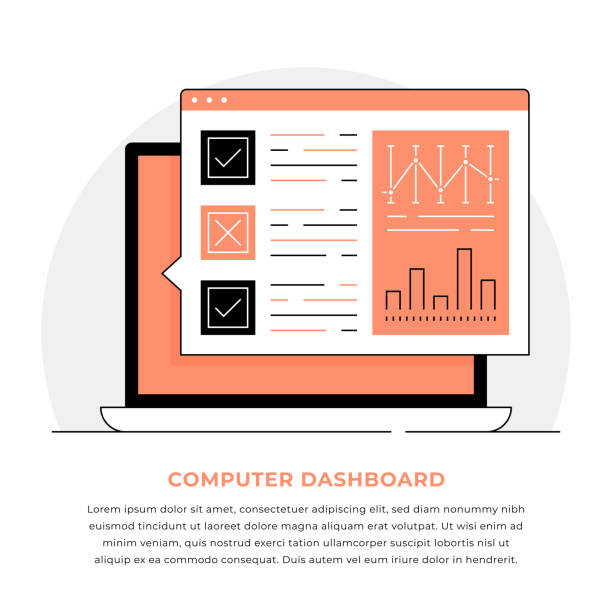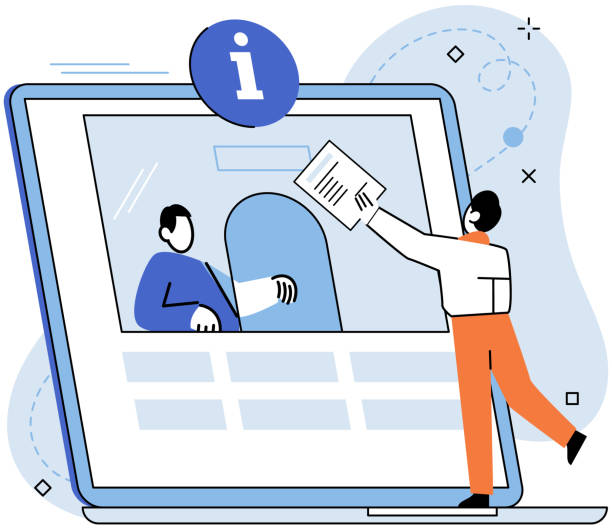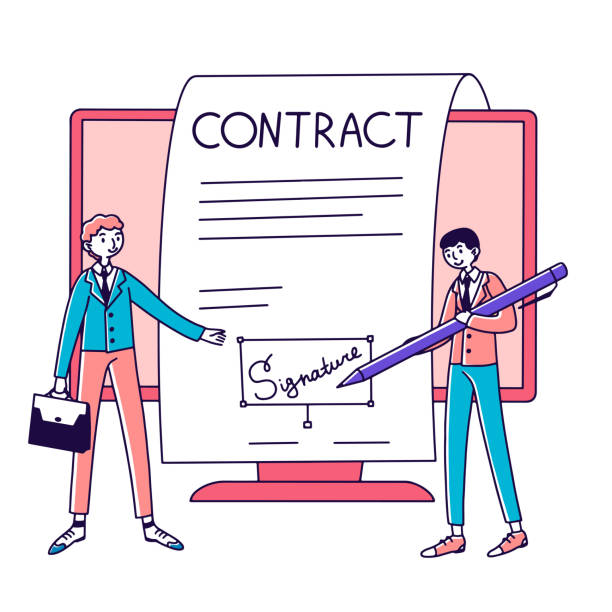Introduction to the Importance of Website Speed in the Digital World

In today’s digital age, website loading speed is not just a competitive advantage, but an absolute necessity for any business or individual seeking an effective online presence.
#FastWebsiteDesign is no longer a luxury option, but a foundation for unparalleled user experience and improved search engine rankings.
Internet users today have very little patience, and research shows that most of them abandon a site if a page takes more than a few seconds to load.
This directly affects your site’s bounce rate and can severely reduce your sales, engagement, and visibility.
Therefore, focusing on fast website design is a vital investment for your long-term online success.
Furthermore, search engines like Google consider site loading speed as an important factor in page ranking.
A faster loading site not only provides a better user experience but also scores higher in terms of SEO and has a greater chance of appearing in top search results.
This is a crucial SEO strategy that should not be overlooked.
Website speed optimization means improving the site’s infrastructure, coding, and content to optimize its loading process for the end-user.
In the rest of this article, we will explore various aspects of how to achieve this goal and discuss practical solutions for achieving a high-speed website.
Does your current website convert visitors into customers or scare them away? Solve this problem forever with professional corporate website design by Rasaweb!
✅ Build strong credibility and branding
✅ Attract target customers and increase sales
⚡ Get a free consultation now!
Key Factors Affecting Your Website Speed

To achieve #FastWebsiteDesign, we must first identify the main factors that affect site loading speed.
These factors are diverse and include everything from technical infrastructure to visual content and site coding.
Understanding these helps you find your website’s weaknesses and focus on improving them.
One of the most important factors is the size of website files; the larger the images, videos, CSS, and JavaScript files, the more time is needed for download.
Another factor is the quality and type of your web hosting.
A weak host or one with limited resources can severely impact your website speed, even if your content is optimized.
Also, improper coding, using too many inefficient plugins, and a lack of proper compression can add an extra burden on the server and user’s browser.
Not using a Content Delivery Network (CDN) to distribute content globally can also negatively affect loading speed for geographically distant users.
Understanding these factors is the first step in the path to speed optimization and achieving fast website design.
These points will be professionally examined to provide practical solutions for each.
Optimizing Images and Media for Faster Website Speed

Images and media are often the main culprits in slow website loading.
To achieve #FastWebsiteDesign, image optimization is a vital and educational step that yields impressive results.
This optimization includes reducing file size without significant quality loss, choosing the appropriate format (such as WebP for the web), and using lazy loading features.
Lazy loading means images are only loaded when the user scrolls to the relevant section, which drastically reduces initial page load time.
Furthermore, using image compression tools and specifying exact image dimensions in HTML prevents loading images with dimensions larger than actually needed.
Image compression is an art that must be performed carefully to avoid visual quality degradation.
Finally, video media should also be carefully optimized; using video hosting platforms like YouTube or Vimeo instead of direct hosting on your server, as well as using lightweight embed codes, can significantly impact your website speed.
These approaches are key to ensuring a fast-loading website.
Table 1: Comparison of Common Image Formats for the Web
| Image Format | Advantages | Disadvantages | Best Use for Speed |
|---|---|---|---|
| JPEG | Good for photos, good compression | Quality decreases with high compression, no transparency support | Large and detailed images |
| PNG | Supports transparency, high quality | Larger file sizes than JPEG, limited compression | Logos, icons, images with transparency |
| WebP | Smaller size with similar quality to JPEG/PNG, supports transparency and animation | Limited older browser support, requires conversion | Best option for most web images (if browser supported) |
| SVG | Vector-based, high scalability without quality loss, small size | Not suitable for complex graphics | Logos, icons, charts |
The Role of Coding and Frameworks in Website Speed
![]()
In addition to visual content, coding structure and framework selection also have a major impact on #FastWebsiteDesign.
Optimized and clean coding, by removing extra code (minification) and consolidating CSS and JavaScript files, can significantly reduce loading time.
This is a specialized topic that requires attention to technical details.
Using lightweight and efficient frameworks instead of heavy and feature-rich unnecessary frameworks helps reduce the overall size of the site.
Also, optimizing database queries, using efficient RESTful APIs, and preventing infinite loops or excessive server requests are other important coding aspects that affect speed.
Code optimization is a necessity for every part of your site, from the server-side (backend) to the client-side (frontend).
This also includes asynchronous loading of scripts and styles, which allows the browser to display the main content of the page without waiting for all files to load completely.
Paying attention to these technical points in the early stages of fast website design prevents future speed issues.
Tired of losing business opportunities due to not having a professional corporate website? Don’t worry anymore! With Rasaweb’s corporate website design services:
✅ Your brand’s credibility and professionalism will increase.
✅ You will attract more customers and sales leads.
⚡ Click now for a free consultation!
Choosing the Right Host and Server for Fast Website Design

Choosing the right host and server is one of the most important decisions for any website aiming for #FastWebsiteDesign.
The type of hosting (shared, VPS, dedicated, cloud) and the quality of the provider’s services directly impact server response time and consequently, site loading speed.
Shared hosting is the cheapest option but offers limited resources, which can lead to slowdowns for high-traffic or content-rich sites.
Using a CDN (Content Delivery Network) is highly recommended.
A CDN reduces loading time significantly by storing copies of your site’s content on various servers worldwide and delivering content from the closest server to the user.
VPS (Virtual Private Server) or dedicated hosting provides more control over server resources and settings and is more suitable for medium to high-traffic sites.
Cloud hosting also offers high flexibility and scalability, allowing you to adjust resources based on your needs.
When choosing a host, pay attention to factors such as server location (close to your audience), technical support, and uptime guarantee.
A good host means a strong infrastructure for your site, which forms the cornerstone of a fast and efficient website design.
These guidelines will help you make the best decision.
Website Speed Evaluation Tools and Tests

To ensure achieving and maintaining #FastWebsiteDesign, regular use of website speed evaluation tools is essential.
These tools help you identify your site’s weaknesses and receive specific recommendations for improving loading speed.
One of the most widely used tools is Google PageSpeed Insights, which not only provides a score for your site’s performance on desktop and mobile but also offers optimization recommendations such as image compression, eliminating render-blocking resources, and reducing server response time.
This is a very valuable educational and analytical tool.
Other tools like GTmetrix and Lighthouse (built into Chrome’s developer tools) also provide comprehensive information about loading speed, page size, number of requests, and other performance metrics.
GTmetrix even allows you to test your site’s speed from different locations and with various browsers.
Regular use of these tools enables you to monitor changes made to your site and ensure optimal website performance.
These guiding steps are an integral part of the site speed optimization process.
Caching and Compression for Instant Website Loading

One of the most powerful methods for achieving #FastWebsiteDesign is using caching and compression mechanisms.
Caching allows browsers or servers to store copies of your website’s static files (such as images, CSS, JavaScript) so that they don’t need to be re-downloaded from the server on subsequent visits.
This process significantly reduces page loading time for returning users and is a specialized approach to optimization.
Caching can be done at various levels: Browser Caching, which stores files on the user’s device; Server-side Caching, which stores server responses; and CDN Caching, which stores content on servers close to users.
Alongside caching, compressing files using algorithms like Gzip is also crucial.
Gzip reduces the size of HTML, CSS, and JavaScript files by up to 70%, leading to reduced download times and thus faster website loading.
Activating these capabilities on the server or using relevant plugins in Content Management Systems is a fundamental step towards significantly increasing the speed and stability of your fast website.
Table 2: Comparison of Caching Methods for Website Speed Improvement
| Caching Type | Functionality | Advantages | Limitations |
|---|---|---|---|
| Browser Caching | Stores files (CSS, JS, images) on the user’s device | Reduces load time for repeated visits, decreases server traffic | Only effective for returning users, requires server-side configuration |
| Server-side Caching | Stores server-generated responses | Reduces server processing time, increases speed for all users | Requires storage space on the server, may cause issues with dynamic content |
| CDN Caching (Content Delivery Network) | Stores and distributes content on global servers | Reduces latency, increases speed for users worldwide, enhances security | Higher cost compared to other methods, more complex configuration |
Integrated Security and Speed in Websites

One of the perplexing questions in the field of #FastWebsiteDesign is whether security measures can slow down a website. The answer is complex, but in many cases, security is not only not in conflict with speed but can also complement it.
Using an SSL/TLS certificate (for enabling HTTPS) is a prime example.
In the past, it was thought that HTTPS encryption might slow down speed, but with technological advancements, this overhead has become very negligible, and its security and SEO benefits are much greater.
HTTPS not only encrypts data but also enables the use of faster communication protocols like HTTP/2.
In addition to SSL, security solutions such as Web Application Firewalls (WAF) and protection against DDoS (Distributed Denial of Service) attacks can also indirectly help improve speed.
These tools reduce the load on the server by blocking malicious traffic and excessive requests, ensuring that your server is available to deliver content to real users.
Therefore, investing in security not only protects your site from threats but also significantly contributes to the stability and fast performance of your website.
This is an analytical view that shows security is a speed-enhancing factor in fast website design.
Do you have an online store but your sales aren’t as expected? Rasaweb solves your problem forever with professional e-commerce website designs!
✅ Significant increase in conversion rates and sales
✅ Unparalleled user experience for your customers
⚡ Click to get a free consultation with Rasaweb now!
Responsive Design and Mobile User Experience

In today’s world, where users are increasingly accessing the internet from mobile devices, responsive design and mobile user experience are no longer an extra feature, but the cornerstone of #FastWebsiteDesign and online success.
A responsive website means a site that automatically adjusts its layout and content to the user’s screen size, providing an optimal experience on any device, from desktops to tablets and smartphones.
This approach is crucial for mobile users who may be using slower internet speeds.
Optimizing for mobile goes beyond merely being responsive; it includes optimizing images for smaller displays, reducing the need for horizontal scrolling, and designing buttons and forms in a way that can be easily touched with a finger.
Google, by emphasizing Mobile-First Indexing, has shown that it considers the mobile version of your site as the primary version for ranking.
Therefore, focusing on responsive design and providing a fast and seamless user experience on mobile is not only beneficial for your users but also vital for your SEO and site visibility and is considered an inseparable part of fast website design.
The Future of Fast Website Design and Emerging Technologies

The future of #FastWebsiteDesign is intertwined with emerging technologies and new trends that are transforming user experiences.
This is a news and exciting area with great potential to change the face of the web.
One such technology is AMP (Accelerated Mobile Pages), which provides incredibly fast versions of web pages for mobile.
AMP, by using limited HTML and CSS and specific optimizations, makes page loading almost instantaneous, especially in mobile search results.
Progressive Web Apps (PWAs) are another important advancement that enables websites to function like native applications, with capabilities such as offline work, push notifications, and home screen access.
These technologies significantly contribute to improving the speed, reliability, and interactivity of websites.
Furthermore, new communication protocols like HTTP/3, built upon the QUIC protocol, promise faster and more reliable web communications.
Artificial intelligence and machine learning can also be used in the future to automatically optimize site speed and personalize the user experience.
These advancements outline an exciting future for fast website design and the web in general.
Frequently Asked Questions
| Row | Question | Answer |
|---|---|---|
| 1 | What is meant by fast website design? | Fast website design refers to the process of launching a functional and optimized website in the shortest possible time, without sacrificing quality or efficiency. |
| 2 | What factors are effective in website design speed? | Using ready-made Content Management Systems (CMS) like WordPress, optimized ready-made templates, visual design tools, designer experience, and effective communication with the client. |
| 3 | Does fast website design always mean reduced quality? | No, with proper planning, use of optimized tools, and standard techniques, a high-quality website can be designed in a short time. |
| 4 | What types of websites are most suitable for fast design? | Small corporate websites, blogs, online resumes, landing pages, and online stores with limited products. |
| 5 | What is the role of CMSs (like WordPress) in fast design? | CMSs significantly speed up the design and development process by providing templates, plugins, and an easy-to-use administration panel. |
| 6 | Does fast website design cost less? | Usually yes. Due to reduced designer working hours and the use of ready-made resources, costs can be significantly lowered. |
| 7 | What client information is needed for fast design? | Contact information, logo, text content, images, website goals, and any specific customization needs. |
| 8 | Do fast-designed websites have future development capabilities? | Yes, especially if built with popular CMSs like WordPress, new features can easily be added to them in the future. |
| 9 | What are the benefits of fast website design for businesses? | Faster market entry, testing new ideas with minimal risk, cost reduction, and the ability to launch immediate marketing campaigns. |
| 10 | What is the difference between fast website design and “ready-made website”? | Fast design involves the process of design and implementation based on client needs, even if it uses ready-made tools. However, “ready-made website” usually refers to platforms where you simply enter your information and receive a pre-defined site. |
And other services of Rasaweb Advertising Agency in the field of advertising
Smart Customer Journey Map: An innovative service for improving SEO ranking through user experience customization.
Smart Advertising Campaign: An effective tool for analyzing customer behavior with the help of precise audience targeting.
Smart UI/UX: A fast and efficient solution for user interaction focusing on attractive user interface design.
Smart UI/UX: An innovative service for increasing click-through rates by using real data.
Smart Digital Advertising: A creative platform for improving user engagement by optimizing key pages.
And over hundreds of other services in the field of internet advertising, advertising consultation, and organizational solutions
Internet Advertising | Advertising Strategy | Advertorial
Sources
Website SEO Guide
Website Speed Optimization
Principles of Responsive Design
Best Web Design Practices
❓ If you are looking to gain visibility and significant growth for your business in the digital space, Rasaweb Afarin Digital Marketing Agency, with expertise in website design with a modern user interface, SEO, and comprehensive online marketing strategies, is your reliable partner.
📍 Tehran, Mirdamad Street, next to Bank Markazi, Southern Kazeroon Alley, Ramin Alley No. 6



